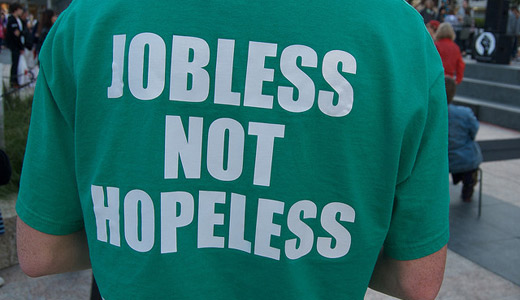
WASHINGTON – The U.S. ended 2012 with a 7.8 percent jobless rate in December, unchanged from the month before and down 0.7 percent from the end of 2011. Private businesses claimed to create 155,000 new jobs in December, bringing their cumulative total for the year to 1.8 million, the same number they created in 2011.
The number of jobless was 12.2 million in December, up 164,000 from the month before but down 843,000 from the end of 2011, when joblessness was 8.5 percent, Bureau of Labor Statistics data show.
The job creation data showed the nation is still slowly recovering from the Great Recession, also known as the Bush Crash, when unemployment doubled from around 5 percent to – after he left office – 10 percent in late 2010. It has gradually declined ever since, due to recovery measures that Democratic President Barack Obama and labor pushed through the then-Democratic-run 111th Congress. Those measures are expiring.
But the Republican-run 112th Congress, which staggered to a conclusion on Jan. 2, 2013, ignored union lobbying and enacted no job-creation laws. In its last gasp, it extended federal jobless benefits for a year. That will help the 39.1 percent of all jobless in December who have been out of work at least six months, and exhausted their state benefits. At the end of 2011, 42.8 percent of unemployed were jobless at least six months.
Factories added 25,000 jobs in December. That brought factory employment to 11.9 million, 180,000 more than in Dec. 2011. Cars and parts (+4,800) was the biggest factory job gainer in December and in the year (+52,200), as the Detroit 3 automakers continued their recovery from the depths of the crash. The second largest factory gains in 2012 were in fabricated metal products – steel for the cars (+40,500). Petroleum, coal, plastics, rubber and chemical plants added 24,000 jobs in 2011.
Construction added 30,000 jobs in December and 118,000 for the year, reflecting the sluggish recovery of the housing market and construction there. There were 564,800 jobs in homebuilding in December, up from November’s figure, but down 6,600 from the end of 2011. And 1.1 million (13.5 percent) construction workers were officially jobless at the end of 2012, down from 1.33 million – one out of six – at the end of 2011.
Construction union leaders say the jobless data underreports the distress among their workers, as a worker who’s working even one day – in the week BLS uses for its counts – is considered employed. BLS said all the jobless, the underemployed – those who take part-time work when they really want full-time jobs – and discouraged workers were 14.4% of the labor force at the end of 2012, down from 15.2% at the end of 2011.
Two low-paying occupations, health care, and bars and restaurants, added thousands of jobs in December and during the year. Health care added 44,500 jobs in December and almost 338,000 during the year. There were 14.52 million health care workers at the end of 2012. Bars and restaurants added 38,000 jobs in December and 53,000 for the year. 2012 ended with 10.04 million people in that sector.
The federal government shed 42,000 workers during the year, down to 2.794 million. The losses were evenly split between the Postal Service (-17,400) and the rest of the government (-24,300).
But neither figure reflects GOP schemes for cutting federal workers’ jobs – and freezing their pay for the third year in a row – or the Postmaster General’s plan to shrink USPS by 100,000 through attrition and another 100,000 in firings.
Postal unions, led by the Letter Carriers, say there are better ways to end the agency’s problems than firing works and cutting service. USPS ended the year with 602,000 workers.
The number of state government workers rose by 24,000 during the year, to 5.072 million, but that was offset by a 50,000-job slash in local governments, to 14.059 million. All of the cuts were in local schools.
“The jobs report was status quo,” said Heidi Shierholz of the Economic Policy Institute. “The labor market added 155,000 jobs in December, right in line with the 153,000 average of the first 11 months of the year, and the unemployment rate, at 7.8 percent, was unchanged.
“The problem, of course, is that a status quo report in today’s labor market represents an ongoing jobs crisis. The jobs deficit – the number of jobs lost since the recession officially began five years ago plus the number of jobs we should have added just to keep up with the normal growth in the potential labor force – remains nearly nine million. At December’s growth rate the labor market will not fill in that gap until the end of 2021,” she added.
AFL-CIO President Richard Trumka added the data show “deep problems remain in our economy and labor market. Under-employment remains at 14.4 percent, wages are barely growing, and too many workers are seeing their skills atrophy as they sit on the sideline of our economy. Our urgent focus must be on investment that creates jobs and lays the foundation for sustainable growth and shared prosperity.
“Even with renewed job growth in recent months, we remain years away from regaining jobs lost during the Bush recession and financial crisis. We need the policies that will make the economy work for everyone, not just Wall Street and the super-rich.”
Photo: Steve Rhodes // CC 2.0

MOST POPULAR TODAY


“Trail of Tears Walk” commemorates Native Americans’ forced removal

Hold the communism, please: SFMOMA’s Diego Rivera exhibit downplays artist’s radical politics

‘Warning! This product supports genocide’: Michigan group aims to educate consumers

After months of denial, U.S. admits to running Ukraine biolabs






Comments